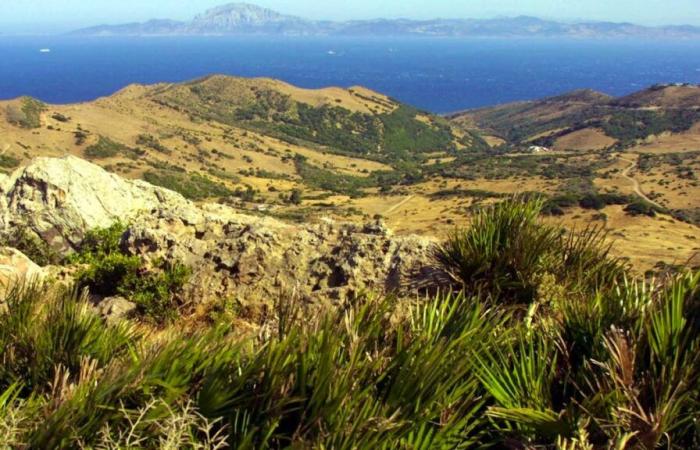View of the Strait of Gibraltar with, offshore, the Moroccan coasts. It closed 5.5 million years ago, cutting off the Mediterranean from the Atlantic.
AFP
The Mediterranean lost 70% of its water 5.5 million years ago, a spectacular drying up due to a period of closure of the Strait of Gibraltar, according to a study published Monday.
The narrow maritime passage, which separates Spain from Morocco, plays an essential role in this ecosystem. The rivers which supply the Mediterranean with fresh water are in fact too few in number to compensate for the evaporation of sea water. This imbalance is counterbalanced by the exchange of water between the sea and the Atlantic Ocean across the strait. On the surface, Atlantic water enters the Mediterranean; at depth, the saltier Mediterranean water flows out towards the Atlantic.
If this passage were blocked today, this would cause a drop in sea level “of around 0.5 meters per year”, recall the authors of the study published in “Nature Communications”.
This is what happened, between 5.97 and 5.33 million years BCE, at the end of the Miocene. The blockage of the strait, due in particular to the movements of tectonic plates, limited water exchanges between the Mediterranean and the Atlantic Ocean, which led to a concentration of salts in the sea.
This episode, called the “Messinian salinity crisis”, in reference to the Italian city of Messina, left visible traces: the bottom of the Mediterranean is “covered with a layer of salts which is up to 2-3 km deep. ‘thickness’ and totals one million cubic kilometers, Giovanni Aloisi, CNRS researcher and geochemist at the Institute of Globe Physics, explains to AFP.
But the extent of the drop in sea levels during this crisis remained debated until now. “Certain hypotheses said that the level of the Mediterranean had practically not fallen, others that the sea had practically emptied,” underlines Giovanni Aloisi, who led the study.
A drop in level of up to 2.1 km
Thanks to the analysis of the chlorine isotopes contained in the salts extracted from the bottom of the Mediterranean, it shows that this episode actually took place in two stages. During a first phase, of around 35,000 years, the Mediterranean was “full of water, like now”, but the narrowing of the Strait of Gibraltar “made the exit of salt water towards the Atlantic a little more difficult », causing an accumulation of salts in its eastern part and making the sea brackish, details the researcher.
The second phase was much shorter, around 10,000 years. The strait was “completely closed”, the Mediterranean was “separated” from the Atlantic and water exchanges with the ocean were interrupted, he continues. Salts then accumulated everywhere and the sea dried up.
The water level fell by 1.7 to 2.1 km in its eastern part and by approximately 850 m in its western part. In total, the Mediterranean basin has lost 70% of its water volume. Until the Strait of Gibraltar opens again and the sea fills up again.
This drying had spectacular consequences on the landscape and biodiversity of the Mediterranean, where fish and cetaceans then spawned. “Only micro-organisms can live at such levels of salinity,” notes Giovanni Aloisi.
A land bridge between Africa and Europe
In the western part, the lowering of sea levels would have led to the formation of a land bridge connecting Africa and Europe. This would have allowed “the colonization of the Balearics by mammals” from the continent, goats, rodents and rabbits, as shown by previous studies, he adds.
The drop in sea level would also have modified atmospheric circulation over the Mediterranean basin. And even increased volcanic activity in the region.
“70% of the volume of the Mediterranean represents an enormous mass of water, which exerts pressure on the lithosphere”, the outer crust of the Earth, explains the researcher. When this pressure is relieved by falling sea levels, the formation of magma and its migration to the surface is facilitated, making eruptions more plausible.
(afp)






